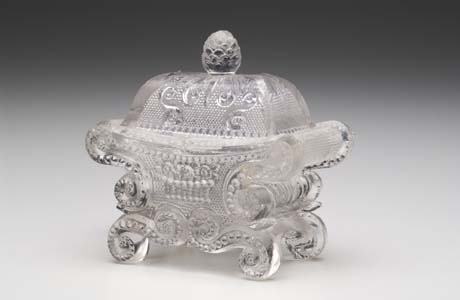Ongoing
Mint Museum Randolph
 |
 |
|
Boston & Sandwich Glass Company,
Sandwich, Massachusetts, 1825-1888.
Covered Salt, 1830-40, lead glass.
Gift of Mrs. Ralph Philip Hanes in honor of her aunt, Mrs. Paul Chatham.
|
Steuben Glass Works,
Corning, New York, 1903-.
Pair of Goblets, circa 1925, glass.
Gift of Mary Brandwein.
|
The nineteenth and early twentieth centuries represent a time of extraordinary growth for the American glass industry. Companies such as Boston & Sandwich Glass Company in Sandwich, MA; Steuben Glass Works in Corning, NY; and Libbey Glass Company in Toledo, OH, began operation and soon developed notable reputations for producing fashionable wares that were coveted by many middle- and upper-class consumers. American Glass showcases approximately forty-five objects by these and other American glass companies to illustrate the variety of forms and styles that prevailed during this period. Glass-manufacturing techniques are another focus of the exhibition, with representative examples of pressed, cut, blown, and molded glass. This exhibition has been organized by The Mint Museum and is on view in the Bridges and Levine Galleries at Mint Museum Randolph.
American Glass Manufacturing Techniques
Pressed
This technique, first invented by American John P. Bakewell for furniture knobs, involves the use of a plunger to press glass into a mold. To learn more about pressed glass, read this brief history on antique pressed glass from the Early American Pattern Glass Society.
Cut
Cut glass reached its popularity in the late 1800s during the American Brilliant Period when American producers made efforts to compete with European glass manufacturers. This time-consuming and expensive technique involves cutting facets into the otherwise smooth glass by holding and pressing the piece against rotating metal or stone wheels to produce the desired pattern. To find out more on cut glass, read this article on American cut glass from Collectors Weekly or visit the American Cut Glass Association's article section.
Blown
Glassblowing is the process of taking molten glass on the end of a hollow pipe and inflating it with one's breath. This ancient technique dates back over two thousand years. This article from Antiques & Fine Arts Magazine contains more detailed information on 19th century blown glass.
Molded
Molded glass involves a similar technique to traditional glassblowing. Rather than being freely blown, the molten glass is blown into a mold. American glass manufacturers used molds as an inexpensive way to achieve a similar look to cut glass. Learn more about American molded glass from this Collectors Weekly article.
Online Resources on Featured Glass Companies
Atterbury and Company
Beatty-Brady Glass Company
Boston & Sandwich Glass Company
Bryce, Higbee & Company
Cambridge Glass Company
Challinor, Taylor and Company
Coventry Glass Works
Edris Eckhardt
Fenton Art Glass Company
Fislerville Glass Works
Frederick Carder
Gillinder and Sons
Hobbs, Brockunier and Company
J. Hoare and Company
Libbey Glass Company
Lustre Art Glass Company
Mount Washington Glass Company
New England Glass Company
Quezal Art Glass and Decorating Company
Steuben Glass Works
T. G. Hawkes and Company
Tiffany Furnaces
Willington Glass Works
Selected Resources Available in The Mint Museum Library
- Eckhardt, Edris. Edris Eckhardt: visionary and innovator in American studio ceramics and glass. Lakewood, OH: Cleveland Artists Foundation, 2006.
- Eidelberg, Martin. Tiffany Favrile Glass and the Quest for Beauty. New York: Lilian Nassau LLC, 2007.
- McKearin, George S. and Helen McKearin. American glass. New York: Crown Publishers, 1948.
- Madigan, Mary Jean Smith. Steuben Glass: an American tradition in crystal. New York: H.N. Abrams, 1982.
- Shuman, John A. The collector's encyclopedia of American art glass: a vivid color guide to numerous art glass types. Paducah, KY: Collector Books, 1988.
- Spillman, Jane Shadel. The American cut glass industry: T.G. Hawkes and his competitors. Woodbridge, Suffolk, UK: Antiques Collectors Club, 1996.
- Wilson, Kenneth M. American glass, 1760-1930: the Toledo Museum of Art. New York: Hudson Hills Press in association with the Toledo Museum of Art, 1994.
____________________________
Created by Nicole Jacobson, volunteer at The Mint Museum Library